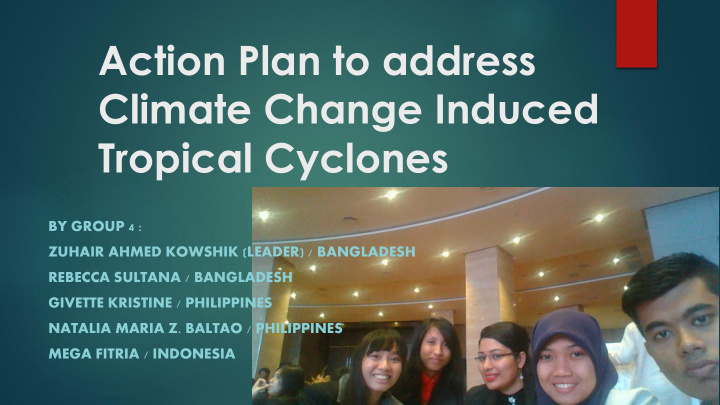



Action Plan to address Climate Change Induced Tropical Cyclones BY GROUP 4 : ZUHAIR AHMED KOWSHIK (LEADER) / BANGLADESH REBECCA SULTANA / BANGLADESH GIVETTE KRISTINE / PHILIPPINES NATALIA MARIA Z. BALTAO / PHILIPPINES MEGA FITRIA / INDONESIA
Background Is characterised by a low pressure centre strong winds, and spiral arrangement of thunderstorms that produce heavy rain Impact of tropical cyclone Tropical Cyclone example: Bhola cyclone (1970), SIDR, AILA, Nargis, etc. Cyclone impact Cyclone form Cyclone impact http://scienceillustrated.com.au http://en.wikipedia.org/wiki/Effe /blog/science/scientists- cts_of_tropical_cyclones#/medi uncertain-how-climate-change- a/File:Hurricane_katrina_damag affects-cyclone-behaviour/ http://www.abc.net.au e_gulfport_mississippi.jpg
The Effects On Young People education -destroyed facilities -lack of participation due to trauma employment : youth are forced to seek jobs due to marginalization health -mental : trauma, mental illness, violence -malnutrition -diseases crime rate -young people are more vulnerable -people become desperate migration/displacement : migrate to find better opportunities for life because they become desperate
Personal Commitment Plant trees in the coastal regions Proper waste segregation (flood risks due to tropical cyclones) Share knowledge about the cyclones (social media, videos, photos) Educating our family and friends and then the community Raise awareness in coastal people
Organization’s Commitment STEPS NEEDED AND HOW THEY WILL BE DONE HELP AND RESOURCES WE NEED I. Widespread information 1. Collection · contacting local communities local volunteers · survey consultants · FGDs disaster management authority · case studies cooperation of agencies · analysis of previous data (history analysis) · contact the local government, meteorological departments, organizations involved 2. Dissemination · print and local media (radio, religious institutions, TV, tarpaulins, fliers) material resources · social media cooperation of media · involve educational institutions equipment for dissemination (handmikes, flags) coordination with educational institutions coordination with agencies
STEPS NEEDED AND HOW THEY WILL BE DONE HELP AND RESOURCES NECESSARY II. Help Government for proper capacity and vulnerability assessment (CVA) 1. Gathering Volunteers and Developing their Skills · contacting organizations contacts · Schools 2. Building effective early warning system in local language · local language knowledge and accent local language 3. Performing mock drills and simulations local organizations coordination with educational institutions and local communities 4. Raising awareness · campaigns, workshops, summits 5. Promoting disaster education coordination with the educational board and national curriculum authority
Recommendations to the World Leaders Effective regional and local coordination and 1. communication between stakeholders for facing tropical cyclones Afforestation in coastal areas 2. Exchange of information and expertise between nations 3. Cyclone Preparedness Plan (CPP) / Comprehensive 4. national plan for each nation regarding tropical cyclones Disaster Risk Assessment specifically for tropical cyclones 5. Build gender-friendly cyclone shelters/evacuation 6. centers
THANK YOU DHONNOBAD SALAMAT PO TERIMAKASIH
Recommend
More recommend